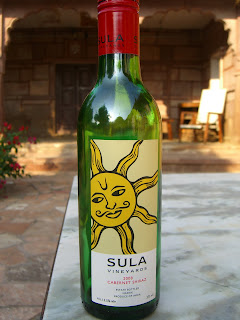So the wife had the bright idea of ordering a load of cheap fizzy in time for Christmas in order to keep the family lightly gassed throughout the nightmare we know as the Festive Period. She found Tesco Cava Brut going for a fantastic around-£4-a-bottle special deal and ordered two cases. Then the snow fell and along with Heathrow Airport, the rest of the UK came to a halt, all our booze with it. No-one knew where it was, not us, not Tesco. It might possibly have been marooned in a delivery hub in Warrington, possibly not. Christmas edged nearer, no drink, Tesco promised pitifully that it would arrive in time for Christmas Eve. Christmas Eve came and went, as did Christmas Day, Boxing Day and the New Year holiday. Nothing.
Our grog finally turned up, quite unexpectedly, in mid-January. Good news was that they delivered vastly more than we'd asked for, presumably in some token of apology. No no, we cried as the light was blotted out by mountains of cardboard boxes, some mistake, but the delivery guys just shrugged and heaped the cases up in the hallway. Not only that, but Tesco threw in some fancier Cavas (Codorniu and Marques de Monistrol, 2006 vintage), I think because they'd run out of the rock-bottom stuff we'd actually ordered.
Bad news too, because of course by mid-January everyone had checked into rehab to get over Christmas, and there was no possibility of our even beginning to drain the Cava lake which had suddenly welled up in our lives. Moreover, it is now the end of March, and we still have thirty-two bottles to get through, and with the best will in the world, I am starting to struggle.
Not that there's anything wrong with the basic Tesco Cava, as long as you chill it to death. I know a guy who once worked with the Freixenet company and he was told (by the boss, indeed) that the way to serve Cava was to chill it so much that ice crystals formed in the glass as you poured it. Which is terrific if you're in, say, Madrid, on a hot June night, less so in England in winter. Still, my routine is to get the Tesco product down to a hairsbreadth above absolute zero, and what do I find but a nice prickly mousse, followed by a hint of burnt caramel on the tongue, then a ferocious poof as it expands rapidly across the floor of the mouth like a CO2 fire extinguisher, leaving only a chesty rasp in its wake. It passes the time very agreeably, especially when you consider what we paid.
Then I get bored. I still have over thirty bottles to get through, and how long does this stuff keep? PK suggests six months, but that's counting from January, which means I now have four months in which to neck my thirty bottles, which is roughly two bottles a week, and even with help from the wife and anyone else around, I don't think I have that much frivolity in me. So I try and trick myself into thinking the Tesco Cava is something else, not Cava, by adding things to it.
Not the home-made sloe gin which no. 1 son once used to make an intriguing Champagne cocktail, only to discover that it produced a lethal fizzy syrup, a kind of psycho cherryade. No, I have professional kit, charitably donated in second-hand form by our French friends, in the form of an almost-empty bottle of Cassis; some Crème de Figue, similarly used; and a bottle of Crème de Pêches, almost untouched, which should have told me something.
As it turns out, the Cassis Is the only one I can look forward to without some degree of apprehension. It may have gone a bit brown in colour and have a certain amount of jammy horror around the neck, but Tesco Cava + elderly Cassis = quite a funky sensation of cloves and gravy browning, oddly warming in the context of the frigid Cava. The Figue, by way of contrast, while starting off with a promising chocolately introduction, turns fairly quickly into a garbled story of deodorant, granulated sugar and aircraft dope. I want to like it, being the nearest in character to that slinky Crème de Noisette you sometimes find, but is it decrepitude? An inferior brand? Inherent nastiness? Something morbid turns the Figue into a drink occupying the narrow isthmus that connects the quixotic to the merely weird, and I cannot bring myself to love it.
But at least it's not the Crème de Pêches. Peaches are lovely things. The label alone enchants. So why has it been barely touched? Well, as it turns out, it breaks new ground in potable filth. I get as far as discovering that yes, drain cleaner and marzipan can be found in the form of an alchoholic drink, before reflexively tipping the rest down the sink, an action I almost never perform in the real world. Toxic is the only word.
And then I sit and stare angrily at the still-fairly-full Crème de Pêches bottle, and at the thirty remaining Tesco Cavas. Who would have thought it could be so challenging?
CJ


